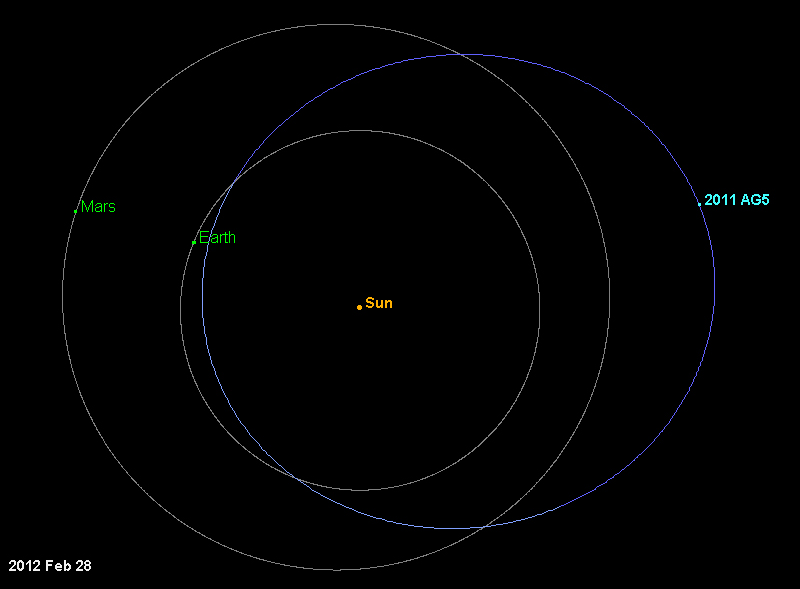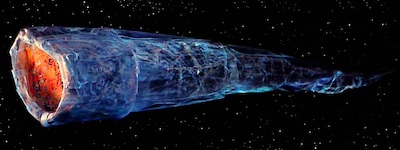Skip to comments.
NASA’s Planetary Radar Captures Detailed View of Oblong Asteroid
JPL ^
| Feb. 17, 2023
Posted on 02/19/2023 10:11:24 AM PST by BenLurkin
One of the most elongated asteroids ever imaged by planetary radar was closely tracked by the agency’s Deep Space Network.

This collage shows six planetary radar observations of 2011 AG5 a day after the asteroid made its close approach to Earth on Feb. 3. With dimensions comparable to the Empire State Building, 2011 AG5 is one of the most elongated asteroids to be observed by planetary radar to date.
Credit: NASA/JPL-Caltech
On Feb. 3, an asteroid more than three times as long as it is wide safely flew past Earth at a distance of about 1.1 million miles (1.8 million kilometers, or a little under five times the distance between the Moon and Earth). While there was no risk of the asteroid – called 2011 AG5 – impacting our planet, scientists at NASA’s Jet Propulsion Laboratory in Southern California closely tracked the object, making invaluable observations to help determine its size, rotation, surface details, and, most notably, shape.
This close approach provided the first opportunity to take a detailed look at the asteroid since it was discovered in 2011, revealing an object about 1,600 feet (500 meters) long and about 500 feet (150 meters) wide – dimensions comparable to the Empire State Building. The powerful 230-foot (70-meter) Goldstone Solar System Radar antenna dish at the Deep Space Network’s facility near Barstow, California, revealed the dimensions of this extremely elongated asteroid.
“Of the 1,040 near-Earth objects observed by planetary radar to date, this is one of the most elongated we’ve seen,” said Lance Benner, principal scientist at JPL who helped lead the observations.
The Goldstone radar observations took place from Jan. 29 to Feb. 4, capturing several other details: Along with a large, broad concavity in one of the asteroid’s two hemispheres, 2011 AG5 has subtle dark and lighter regions that may indicate small-scale surface features a few dozen meters across. And if the asteroid were viewed by the human eye, it would appear as dark as charcoal. The observations also confirmed 2011 AG5 has a slow rotation rate, taking nine hours to fully rotate.
Beyond contributing to a better understanding of what this object looks like up close, the Goldstone radar observations provide a key measurement of the asteroid’s orbit around the Sun. Radar provides precise distance measurements that can help scientists at NASA’s Center for Near Earth Object Studies (CNEOS) refine the asteroid’s orbital path. Asteroid 2011 AG5 orbits the Sun once every 621 days and won’t have a very close encounter with Earth until 2040, when it will safely pass our planet at a distance of about 670,000 miles (1.1 million kilometers, or nearly three times the Earth-Moon distance).

“Interestingly, shortly after its discovery, 2011 AG5 became a poster-child asteroid when our analysis showed it had a small chance of a future impact,” said Paul Chodas, the director for CNEOS at JPL. “Continued observations of this object ruled out any chance of impact, and these new ranging measurements by the planetary radar team will further refine exactly where it will be far into the future.”
CNEOS calculates every known near-Earth asteroid orbit to provide assessments of potential impact hazards. Both the Goldstone Solar System Radar Group and CNEOS are supported by NASA’s Near-Earth Object Observations Program within the Planetary Defense Coordination Office at the agency’s headquarters in Washington. The Deep Space Network receives programmatic oversight from Space Communications and Navigation program office within the Space Operations Mission Directorate, also at the agency’s headquarters.
TOPICS: Astronomy
KEYWORDS: asteroid; donatetofreerepublic; nasa; oblong; radar
Navigation: use the links below to view more comments.
first 1-20, 21-30 next last
1
posted on
02/19/2023 10:11:24 AM PST
by
BenLurkin
To: BenLurkin
I saw that show.
You have to fly a starship into it to stop it.
2
posted on
02/19/2023 10:13:47 AM PST
by
blueunicorn6
("A crack shot and a good dancer” )
To: BenLurkin
3
posted on
02/19/2023 10:15:34 AM PST
by
HYPOCRACY
(This is the dystopian future we've been waiting for!)
To: BenLurkin
4
posted on
02/19/2023 10:16:20 AM PST
by
TangoLimaSierra
(⭐⭐To the Left, The Truth is Right Wing Violence⭐⭐)
To: BenLurkin
What passes for a detailed view for one fellow doesn’t pass as a detailed view for another, or any with functioning eyesight.
5
posted on
02/19/2023 10:25:16 AM PST
by
GingisK
To: BenLurkin
At this point it’s all fake and gay until I see it for myself.
6
posted on
02/19/2023 10:31:27 AM PST
by
Bulwyf
To: Bulwyf
It looks phallic shaped , so you you might be right.
To: GingisK; Bulwyf
It appears to have been......excreted.
8
posted on
02/19/2023 10:35:22 AM PST
by
BenLurkin
(The above is not a statement of fact. It is either opinion, or satire, or both.)
To: Bulwyf
I heard the asteroid identifies as a comet.
9
posted on
02/19/2023 10:35:41 AM PST
by
WeaslesRippedMyFlesh
(wake me up when somebody tells the truth)
To: BenLurkin
“It appears to have been......excreted.”
As long as the aliens dumped their holding tanks outside the legal limit.........
10
posted on
02/19/2023 10:42:50 AM PST
by
doorgunner69
(Let's go Brandon)
To: BenLurkin
11
posted on
02/19/2023 10:43:17 AM PST
by
redshawk
( I want my red balloon. https://youtu.be/VexKSRKoWQY)
To: blueunicorn6
To: BenLurkin
Well, I was thinking it looked like a giant baked potato, but………
13
posted on
02/19/2023 10:57:05 AM PST
by
telescope115
(My feet are on the ground, and my head is in the stars.)
To: GingisK
Perhaps you’d prefer one of those idiotic and utterly useless “artist’s conception” images? I understand that they appeal to a certain sort of person ...
I appreciate seeing real RADAR imagery. Actual data are far superior to fiction.
14
posted on
02/19/2023 11:02:49 AM PST
by
NorthMountain
(... the right of the peopIe to keep and bear arms shall not be infringed)
To: plain talk
15
posted on
02/19/2023 11:07:52 AM PST
by
Bobalu
(Unrepentant communists, NAZI’s and totalitarians of all stripe are bowing toward Davos)
To: NorthMountain
16
posted on
02/19/2023 11:15:19 AM PST
by
Clutch Martin
("The trouble ain't that there is too many fools, but that the lightning ain't distributed right." )
To: Clutch Martin
It’s an inert chunk of rock, orbiting in the vast wastes of interplanetary space.
As such, it is a more valuable part of the grand scheme of the universe than F. Joe Biden.
17
posted on
02/19/2023 11:21:47 AM PST
by
NorthMountain
(... the right of the peopIe to keep and bear arms shall not be infringed)
To: NorthMountain
No, I prefer imaging with a decent optics and properly exposed media from a range that allows viewing surface texture. Please, be happy with your blobs.
18
posted on
02/19/2023 11:24:39 AM PST
by
GingisK
To: GingisK
flew past Earth at a distance of about 1.1 million miles (1.8 million kilometers, or a little under five times the distance between the Moon and Earth). Your puny terrestrial optical telescopes will avail you nothing at that distance.
Now ... if you want to send a small spacecraft, with a nice suite of imaging and spectroscopic instruments on board, to pay it an up close visit ... I might be on board with you on that endeavor.
19
posted on
02/19/2023 11:29:14 AM PST
by
NorthMountain
(... the right of the peopIe to keep and bear arms shall not be infringed)
To: NorthMountain
I don't have any interest in rocks that far away. Knowledge of them serves no useful purpose, especially when that knowledge lacks detail in all fields of endeavor.
The only thing I want to know about those things is their probability of hitting Washington DC during the State of the Union Address.
But, be happy with those pixelated images of sandy-looking turds.
20
posted on
02/19/2023 11:35:47 AM PST
by
GingisK
Navigation: use the links below to view more comments.
first 1-20, 21-30 next last
Disclaimer:
Opinions posted on Free Republic are those of the individual
posters and do not necessarily represent the opinion of Free Republic or its
management. All materials posted herein are protected by copyright law and the
exemption for fair use of copyrighted works.
FreeRepublic.com is powered by software copyright 2000-2008 John Robinson


